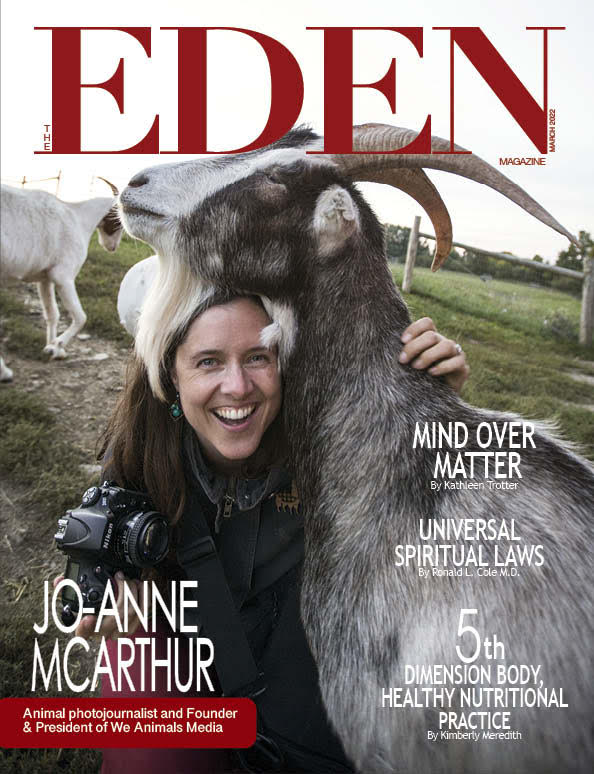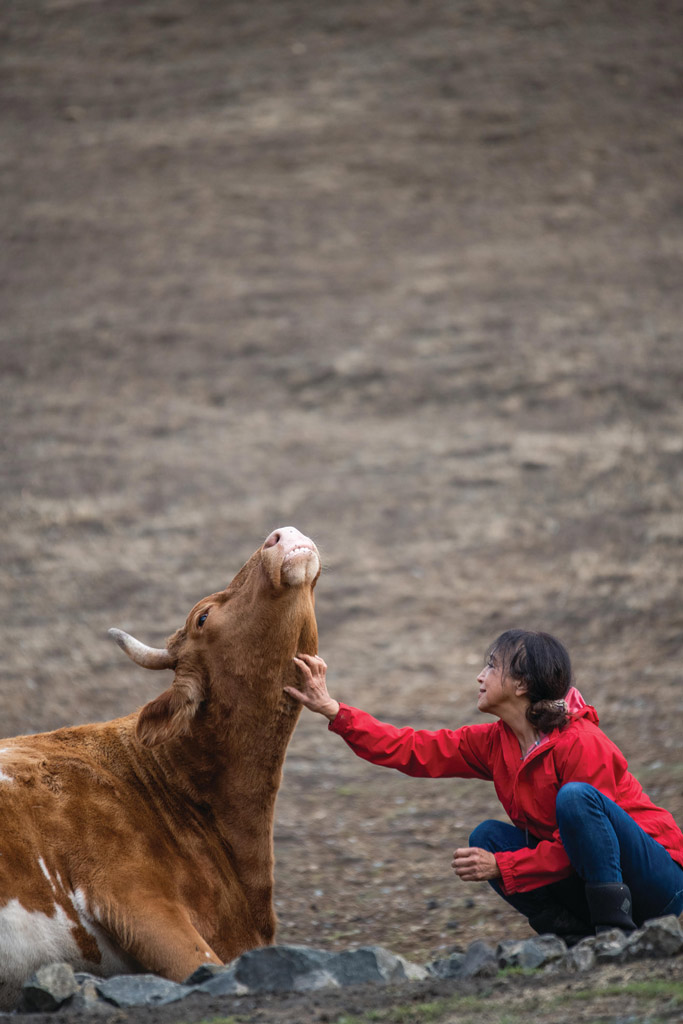
Jo-Anne McArthus
Animal photojournalist and Founder & President of We Animals Media
Jo-Anne McArthur, the founder, president of We Animals Media (WAM) and Animal Right Activist shares her story as a renowned animal photojournalist; behind the closed door and horrors animals experience.
“It’s a very exciting time to be working in the growing field of animal photojournalism. The thousands of visuals we provide are critical contributions to animal stories at this time in history. We Animals Media helps advance important conversations in media, classrooms, law, science, and policy. There’s nowhere I’d rather be working.”
Growing up in Ottawa, Canada, was there someone who guided and encouraged you to follow your current career path?
It was the openness and influence of my first photography teacher, Lorraine Gilbert. I think she was so supportive because my passion was evident. At this moment, as I reflect, I’m reminded of what an enormous responsibility it is to be a teacher. Ms. Gilbert encouraged my love of photojournalism and my ideas about what I could do with it and how it could include animal stories. That was about 25 years ago, and much has changed since my scrappy early days. Now I run a non-profit photo agency whose mission is to tell the stories of animals, and, incredibly, Ms. Gilbert is a monthly donor!
Read Our Magazine…
As we often associate PTSD with military members, you mentioned that in 2010 you were diagnosed with PTSD. Was there one significant event that triggered this?
It developed because I was immersed in investigative work at factory farms. I remember waking up one morning, and the first visual to crystalize in my sleepy brain was that of a pig in a gestation crate. I could see I was slipping from a naturally happy person into some shadow. I told myself that’s not where I want to live. I sought therapy and, to this day, continue to build coping mechanisms for the horrific cruelty I see. It’s so hard because I am not helping the animals I meet. I’m contributing to the end of suffering through public and political change. But I leave those animals behind. It’s sad, frustrating, and haunting. I don’t contribute to their predicament personally because I’m vegan, but I am part of the species that perpetuates the violence.
With so many organizations working to preserve and protect the world’s animals and you working with many organizations, why do you think we have such a hard time changing the mindset of our fellow beings?
Of the philanthropic donations in the US, only 5% are given to environmental and animal causes. While there are a growing number of animal advocacy organizations, they have so little funding! We need billions in funding to be diverted away from less pressing causes, at least for now.
People are slow to change because the status quo is comfortable for some, and we see change as a threat. For example, when challenged to think about giving up eating animals, most people become defensive, thinking it could threaten one’s tradition or culture or greenwashed to worry about what farmers will do if they can’t farm animals. It’s why humane education and critical thinking must be ever-present and developed while we’re young.
When you look back at some of the events you covered, from the rattlesnake roundup in Sweetwater, Texas, to the macaque monkey chained to a windowsill in Ecuador, how do you approach each event to promote change?
I keep my focus on trying to show the experience of the animals in front of me. If I can do that, then we get a glimpse of what we do to them and how they might be suffering as a result. For example, the chicken that is carried upside down to be packed into a crate. Or, the shivering piglet bleeding from his castration without anesthetic, his tail cut off on the very same day. The 20-minute old calf, still wet from birth, looking out from the veal crate with no mother to suckle or be comforted by. These are the experiences I want to connect us with. Billions of animals experience these conditions each year, out of sight.
You launched the We Animals Media project. Would you please tell us when and how you started?
We Animals Media is the effort of my growing team and me to get as many strong visuals as possible out into the world. What used to be just me and my camera, traveling six to eight months each year taking photos of our uses and abuses of animals, has turned into a photo agency with over 60 contributors (both in photography and videography). While my animal photojournalism started in earnest in the early 2000s, the team and I only recently defined it. Many people now call themselves animal photojournalists, which is terrific. The animals need them. It’s different from wildlife and conservation photography in that it includes all animals. We make the work of our contributors available for free to anyone advocating for animals via our incredible stock site, www.weanimalsmedia.org.
Necessity is the mother of invention. Sadly, the world needs a photo agency to focus on these stories, which I’ve now been chasing for two decades. It all began from an insatiable desire to know what harm was happening behind closed doors and to show what I had seen with the world. So, the project, We Animals, grew into We Animals Media, and we are increasingly strategic about what we do and how we do it for maximum impact.

Please tell us about the We Animals Humane Education Program.
While it is no longer a primary focus at WAM, I did spend over a decade giving presentations to school-aged people about animal stories and empathy. In addition, my speaking engagements continue globally, all of them with one goal, to educate people about what we do to animals and make the world a kinder place.
You’ve also launched the Unbound Project, a project about women on the frontlines of animal advocates and activists. What was the energy behind it, and why is it so important to share stories of women advocating for animals?
Everywhere I traveled, women were doing the bulk of the work in animal advocacy. I wondered whether it was true or if I had a bias. So, I did some research. It turned out that 60%-80% of animal advocates were women, but men often remained in positions of power and visibility in animal advocacy organizations. So, I decided to create a project highlighting women’s work and pioneering efforts. My co-author, Keri Cronin, and I launched the project in 2015, and we’ve featured over 60 women from six continents. Lawyers, sanctuary founders, artists, veterinarians, grassroots organizers, you name it. There’s a lot to celebrate and uplift in animal advocacy, and this project does that.
When did you start to become a vegetarian/vegan?
On April 1st, 2003, I started a one-month internship at Farm Sanctuary. Out of respect for the animals, they require you to be vegan while there. I was vegetarian at the time and thought veganism was extreme and probably near impossible. To my surprise, though, after 24 hours of being there amongst the animals who are the survivors of farming industries and 24 hours into being vegan, I felt intellectually and psychologically aligned with who I wanted to be and how I wanted to live. I’ve been vegan since that day.
How do you see or feel that showing more animals in media can positively change how humans treat animals?
Seeing is believing. Ok, at least in part. But, seeing is also one vital piece of the puzzle when it comes to animal emancipation. An image can make an impression instantly, faster than reading an article or a book. Animal photojournalism and videography need to accompany campaigns, news, academia.
We need to make a lot more room for it in the media and the public conscience. I’m really pleased that WAM can contribute to advancing animal rights alongside so many diverse efforts.
Was there ever a time while producing The Ghosts in our Machines that you were threatened by the people you were targeting?
There’s a danger inherent in doing investigations. We enter farms under the darkness of night, trespassing to document what needs to be seen. Investigators get beat up, ticketed, tried, jailed. We get our cameras and cars smashed. We put ourselves through it out of loyalty for the animals, who I see as our clients. They so badly need representatives who aren’t doing the usual photography: their body parts on plates, their secretions in nice tall glasses for kids to drink.
Tell us about your latest book, HIDDEN: Animals in the Anthropocene. What did it mean for you to create this book and why is it important?
Documentary photographers make books on important social issues like wars, famines, genocides, disasters of all kinds. There are books from wildlife and conservation photographers about animals in peril, but all of these books exclude the stories of animals who we raise and kill by the billions each year, and the sea creatures whose death and entrapment numbers are so high that we count them not by the individual but by the tonne. These animals, just like wild animals, and like us, are individuals who can suffer, and who wish to live free from harm. And so their stories are worthy of a book, too.

HIDDEN is a book that chronicles what is at present, and should never again be. It’s a tome of indictments. It’s unflinching and it’s painful. I hope that soon it will be considered a historical book of a dark part in our human history. HIDDEN is a statement that the animals we eat, wear, and use for labour, research, and entertainment, matter too. Readers can find out more here: https://weanimalsmedia.org/hidden/
Do you have any new projects on your way?
Always! The team and I are building our partnerships with NGOs to strategically do more photoshoots, make more films, and reach wider audiences. I’m also very excited about telling more inspiring stories of change and progress. While the disturbing images change hearts and minds, the inspiring stories help steer us in the right direction. We live in a world of possibilities. WAM will do everything we can to move things in the kind direction.
Special thanks to:
Jo-Anne McArthur
Photography:
Louise Jorgensen
Juho Kerola
Lissy Jane
Adam Oswell
Aaron Gekoski
Justin Mott

Comments